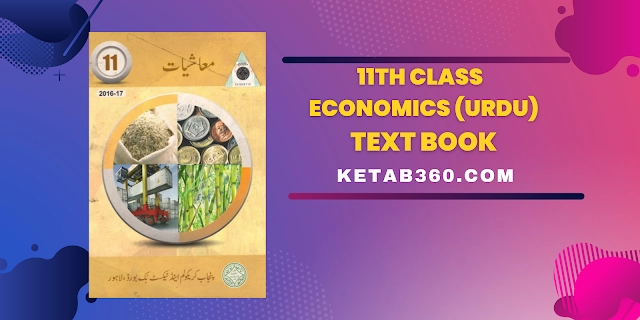11th Class Economics (Urdu) Book By Punjab Board
The economics 1st-year coursebook is used as the optional subject textbook for students studying F.A, ICS, and FSC. While some may perceive economics as similar to mathematics, it is, in fact, a distinct subject with its own principles and concepts.
What does the book contain?
This Punjab Text Book is authored by two subject specialists, ensuring its suitability for young learners who are new to economics. It is available in both English and Urdu mediums to provide better understanding to students. The book consists of 12 chapters, each written in a reader-friendly manner. It is specifically tailored for individuals seeking to grasp the fundamentals of economics.
Chapter No. 1 : Mashiyat Ki Noiyat Or Wasat
This chapter provides an introduction to economics, emphasizing its significance in human life and the pursuit of both economic and non-economic needs. It explores the concepts of goods and services and introduces the idea of utility. It serves as a foundational chapter to familiarize readers with the subject matter.
Chapter No. 2 : Rowaiya Saraf Ka Tajzia
After acquiring a foundation in the fundamental terms of economics and understanding its scope, the subsequent chapter delves into consumer behavior regarding different goods, utilities, and services. It explores the various factors that influence consumer attitudes and discusses the constants and variables involved in this context. This chapter aims to provide insights into consumer decision-making processes.
Chapter No. 3 : Mashiyat Me Shamariyat Or Riazi K Bunyadi Alat
In order to comprehend subjects that entail quantitative measurements, such as physics or chemistry, a reliance on mathematics and statistics becomes imperative. For science students, this chapter will be relatively uncomplicated, as it aims to provide a clear understanding of the fundamental concepts in math and statistics.
Chapter No. 4 : Talab
Supply and demand serve as the fundamental driving forces in the field of economics. This chapter serves as an introduction to the concept of demand, exploring the various laws and variables that influence it. It provides a foundational understanding of the principles underlying demand in economics.
Chapter No. 5 : Rasad
Students will have the opportunity to gain knowledge about the different types of supply, explore the Law of Supply, and understand its limitations. Additionally, the concept of elasticity of supply will be introduced, along with an examination of the factors that influence it. This chapter offers valuable insights into the dynamics of supply in the field of economics.
Chapter No. 6 : Mandi Ka Tawazun
This chapter focuses on the concept of market equilibrium and its significance in maintaining a well-functioning economy. It explores the complexities associated with balancing the market and highlights the importance of economic stability within a region. Students will have the opportunity to learn mathematical expressions that describe market equilibrium, providing them with a deeper understanding of the dynamics of supply and demand in an economic context.
Chapter No. 7 : Nazariya Pedaish Dolat
Production serves as the foundation for supply and demand dynamics in an economy. Without manufacturing and production, economic growth would come to a halt. This chapter provides an in-depth explanation of the factors of production and the entities involved in the production process. Students will gain insights into the essential elements required for generating goods and services and understand the significance of production in driving economic development.
Chapter No. 8 : Pemana Pedaish Aur Qawaneen Hasil
The Law of returns, also referred to as profit, governs the relationship between production and the expected outcomes. Economists perceive this concept differently than the general public. This chapter delves into the analysis of proportional changes in output and input, exploring the intricacies of production and its associated returns. Students will gain a deeper understanding of the economic principles behind production processes and the factors influencing productivity.
Chapter No. 9 : Musarf-e-Pedaish
Production necessitates financial resources, time, and labor. These elements collectively contribute to the costs associated with production. Furthermore, the economic conditions prevailing in a region have a significant impact on the cost of production for various industries and businesses. This chapter provides insights into the factors influencing production costs and highlights the role of the economic environment in shaping production expenses.
Chapter No. 10 : Wasooliyon Ka Tajzia
This chapter explores the functioning of a firm amidst intense competition and examines the revenue trends during periods of economic growth and stability. It delves into the concept of equilibrium in terms of costs and production for firms. Both graphical and theoretical explanations are provided to enhance understanding of these concepts.
Chapter No. 11 : Mandi
This chapter serves as an introduction to the market, where students will become acquainted with various concepts and definitions related to it. It emphasizes the significance of the market, the factors that influence market rates, growth, and competition. Additionally, it explores the concept of market monopoly and how individuals sustain the market.
Chapter No. 12 : Taqseem
What are the various pricing methods and how individuals determine the price of a product or service? This chapter explores the concepts of rent, wages, and their impact on a company’s growth in relation to revenue and marginal cost. It also touches upon the role of labor unions in this context.
Tips for Effective Study of 11th Grade Economics (Urdu) Text Book in PDF Format.
Economics (Urdu) Text Book effectively in the 11th grade can be accomplished even when using PDFs. Consider the following strategies:
To ensure a focused study session while engaging with the Economics (Urdu) Punjab Text Book , consider the following suggestions:
- Disconnect from the internet: Disable internet connectivity while studying to minimize distractions and maintain concentration on the material.
- Keep pen and paper handy: Have a pen and paper nearby to jot down important points, key concepts, or any thoughts that arise during the study session. This aids in better retention and organization of information.
- Utilize the internet selectively: Turn on the internet only when necessary, such as when you require additional information on specific topics. Use it as a supplementary resource rather than a constant distraction.
- Capture screenshots: If you come across confusing sections or passages in the book, take screenshots to share them with your teacher or classmates for clarification and discussion. This promotes collaborative learning and helps in resolving doubts.
- Prioritize eye safety: Take care of your eyes while studying by wearing appropriate protective gear, such as glasses or utilizing screen filters. This ensures your eyes remain safe and minimizes strain during extended study sessions.
By implementing these recommendations, you can enhance your focus, note important points, utilize the internet judiciously, collaborate with others, and safeguard your eyes while studying the Economics (Urdu) Text Book.






